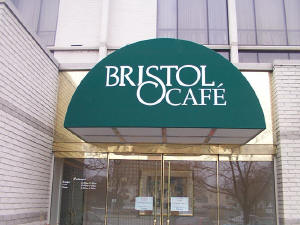1. Hand Painted/Stenciled
This method of producing graphics on fabric is recommended for non back-lit awnings. Paint can be brushed, rolled, sprayed, airbrushed, or silk screened on most fabric types. For back-lit applications, translucent inks can be applied with the same techniques. However, a uniform application of ink is required to achieve consistent light transmission. This can be difficult to accomplish with hand applied processes.
2. Pressure Sensitive (P.S.) Vinyl and Tedlar Films
 This low cost adhesive backed film is available in hundreds of translucent and opaque colors. Pressure Sensitive Films can be computer cut and hand applied. To achieve proper adhesion, P.S. Films should be applied to P.S. Film receptive fabrics. They do not work well on woven acrylic or other canvas like fabrics, or vinyl fabrics that have not been coated with a protective finish. Since translucent films applied on colored fabric will not light properly, back-lit graphics require that P.S. Films be applied onto colored fabrics, the colored fabric must be of the eradicable type so that the fabric color can be removed from areas that are to receive P.S. Films. P.S. Films can also be used as both the background and graphic colors. However, application to large areas is difficult without costly laminating equipment.
This low cost adhesive backed film is available in hundreds of translucent and opaque colors. Pressure Sensitive Films can be computer cut and hand applied. To achieve proper adhesion, P.S. Films should be applied to P.S. Film receptive fabrics. They do not work well on woven acrylic or other canvas like fabrics, or vinyl fabrics that have not been coated with a protective finish. Since translucent films applied on colored fabric will not light properly, back-lit graphics require that P.S. Films be applied onto colored fabrics, the colored fabric must be of the eradicable type so that the fabric color can be removed from areas that are to receive P.S. Films. P.S. Films can also be used as both the background and graphic colors. However, application to large areas is difficult without costly laminating equipment.
3. Eradicated
This economical graphic production method for back-lit awnings, involves the use of solvent to remove the fabric surface color. While the eradication process is a low cost, efficient method of producing back-lit graphics, eradication cannot be performed on most awning fabrics. Instead, it requires specially formulated white vinyl substrate fabrics that have the color applied at the factory by coating the fabric surface with pigmented acrylic inks. These eradicable fabrics are more expensive than Permanent Factory Color Vinyl Fabrics of similar quality. Although eradication is a relatively inexpensive method for producing back-lit graphics, eradicable fabrics are one of the most expensive fabric types. Therefore, this method is most suitable for back-lit projects involving extensive graphics. Once color is removed from the graphic area, other graphic methods, such as the application of P.S. Film, can be used to decorate eradicated areas.
4. Radio Frequency (R.F.) Welding
Radio Frequency Welding is a relatively expensive graphic production method for back-lit graphics. However, R.F. Welding can be performed using most types of fabrics, and does not require the use of expensive eradicable fabrics. Therefore, R.F. Welding can be utilized in a cost effective manner on projects involving small amounts of back-lit graphic areas (relative to overall awning size). The R.F. Welding process involves cutting out the graphic shape from the background fabric, and replacing this area with a slightly larger piece of fabric of the same shape. The two pieces of fabric are then welded together with microwaves and pressure where they overlap.
5. Heat Transfer
This expensive graphic production method is performed on white vinyl fabric substrates to produce vivid, durable back-lit graphics. The entire graphic panel, including the background color, is transferred from ink coated paper to a white substrate, using heat and vacuum pressure. A clear protective top coating is then laminated to the surface using the same heat and vacuum process. The ability to apply protective coatings to the decorated fabric surfaces is a primary justification for the initial higher costs of Heat Transfer. It is recommended for back-lit projects requiring limited reproduction (see Factory Screen Printing for projects requiring multiple reproductions), and maximum longevity. In order to obtain the manufacturer’s warranty, the Heat Transfer process should always be performed using a single manufacturer’s materials (ink paper, substrate fabric, top coating).
6. Direct/Inlaid Digital Printing
Some fabric manufacturers produce custom screen printed back-lightable fabric panels. These panels include the back ground color and the desired graphic elements. The fabric can then be protected with a factory applied clear top coating. Factory Screen Printing is the most cost effective method of producing premium quality back-lightable fabric panels with intensive graphics. However, the normal minimum quantity required for this process is in the 2000 s.f. range. Factory Screen Printing is used most frequently by retail chain stores.
← Awning Anchors & Attachments Awning Engineering Info →


